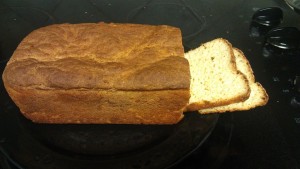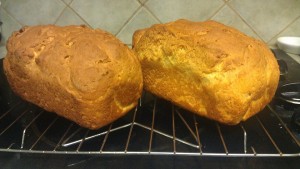In today’s gluten free bread case study, we are taking a look at why gluten free bread fails to rise sometimes. Sekila was working through my Gluten Free Bread 101 class when she wrote this. I love this case study because Sekila realized that her dough was not right and then didn’t hesitate to try to fix it – even though she’s not the chef in the family. Read Sekila’s story and then we’ll analyze what went wrong and what went right at the end:
Enter Sekila:
I don’t cook often, as my chef hubby does most of the cooking in our house. But we are trying to go gluten free for our whole family. This is hard to do with two daughters who prefer to take sandwiches in their daily lunchboxes.
So far I have tried the recipes twice. I found the sandwich bread recipe very easy, except that after I mixed my yeast according to the package, I forgot to add the rest of the water to the amount the recipe stated! When I put my bread in the pan to rise, I wondered why the dough was so thick and “doughy” like wheat dough. When it refused to rise I reread the recipe and realized I had forgotten the water!
Well, I thought to myself, this is gluten-free bread! The whole point of kneeding traditional wheat bread is to entangle the wheat proteins which provide a strechy framework for the bread (I do listen when my chef hubby talks about cooking!!!) It occurred to me that without the gluten, maybe I could mix the water in after the fact, even though the bread had sat for a little while.
I threw my dough back in the mixer with the water and let it run for about 3 minutes. Lo and behold, the dough looked like it was supposed to, just slightly lumpy! The picture of the sliced loaf is that first try. It tasted great, but it fell a bit and was a little moist, but it was OK AND passed the school-lunch sandwich kiddo test!
On my second try, I mixed two batches of the AP flour at the same time (to save some in the freezer) and made two loaves (one to eat, one to freeze). I’m trying not to have to make bread every few days! The second try is the picture of the two loaves…round, brown, perfect and beautiful and perfect inside!!!
The girls have eaten homemade bread ham-and cheese sandwiches all week and STILL say it’s really good. Sometimes after a try or two of something new, they decide they do not like it after all. Not this time. Looking forward to trying the other 2 breads!!!!


What We Can Learn
#1 Thick Gluten Free Bread Dough Doesn’t Rise Gluten free bread dough is just plain different from wheat bread dough. So much so, that experienced wheat bread bakers have the most trouble learning to bake gluten free bread. The dough just doesn’t match up with their intuition about what bread dough should feel like.
If you’re making a loaf of gluten free sandwich bread, then the dough has to rise several inches in the pan. The dough has to be very loose, or it just won’t rise. If you could pick up your dough without having it run through your fingers, then it’s way too stiff, and that recipe needs less flour or more liquids.
#2 You Can Tell A Good Gluten Free Bread Dough By Sight Once you’ve successfully made gluten free bread dough, then you’ll be able to just look at a dough while you’re mixing it and know whether it’s right. The trouble is, how do you know what it should look like if you’ve never made a good loaf of gluten free bread?
That’s where online cooking classes some in. In the Gluten Free Bread 101 class that Sekila was taking, she was able to watch me prepare the bread step-by-step. She learned what the dough should look like by watching the video, and then was able to apply that knowledge to what was going on with the bread in her kitchen.
Proponents of vegan/vegetarian eating claim that rice and beans are a complete protein when combined and that protein counts are meaningless unless the essential amino acids are present in the correct proportions for maximum utilization. Amaranth and quinoa are touted as containing complete proteins. And what about protein powders? There are recipes that incorporate them instead of gluten free flours. I propose that the knowledge gained from experimentation by many on this forum could be shared to zero in on the maximumally nutritious and optimally tasty recipes much more quickly. What combination of ingredients would create the best tasting, most nutritious, most appealing bread, cakes, cookies, brownies and so forth? What do people here already know that they could share?